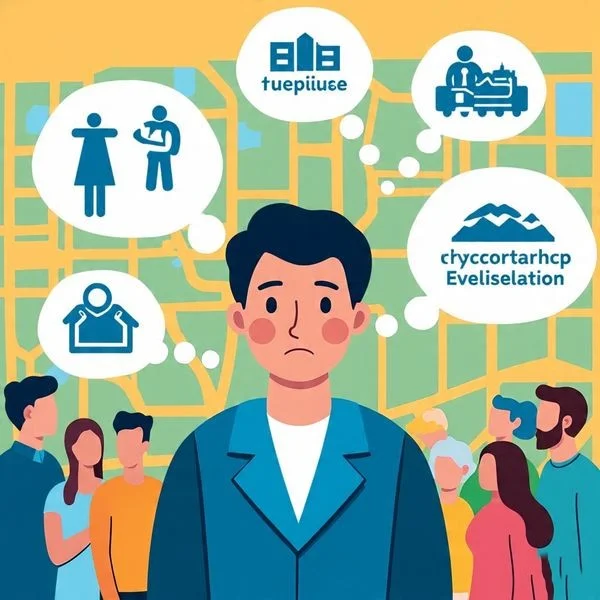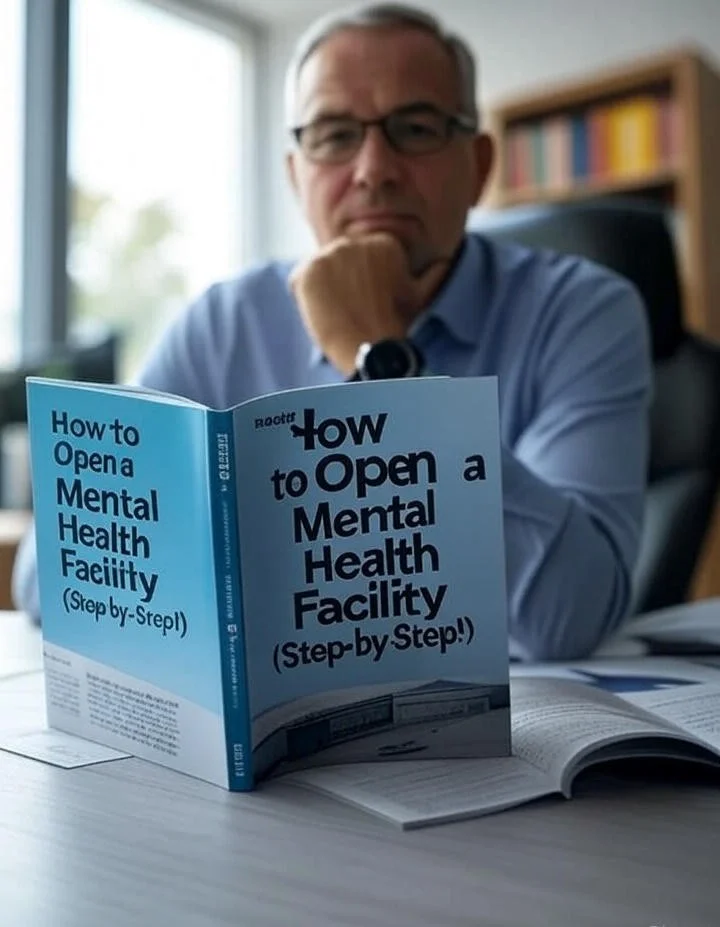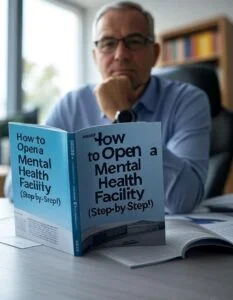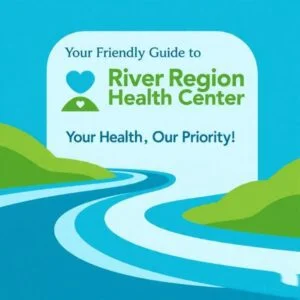Dream of opening a mental health facility? Discover the simple, step-by-step guide on how to open a mental health facility with heart. Make a real difference!
Remember that feeling? Maybe you saw a friend struggle silently. Perhaps someone in your family needed help that felt hard to find. Or maybe you just know your community needs more support. That spark inside you, that pull to help? That’s powerful. And turning that spark into a real place of healing – a mental health facility – is an amazing goal !
You might be thinking, “But how? It sounds huge! Complicated!” I get it. When I first felt that pull, the idea of how to open a mental health facility felt like climbing a mountain in flip-flops. Overwhelming! But here’s the truth: it’s a journey made up of smaller, manageable steps. Like building anything meaningful, you do it brick by brick, heart by heart.
This guide is your friendly map. We’ll break down the big dream into simple pieces. No confusing jargon, just clear steps and real talk. Think of it as chatting with a friend who’s been there (well, not exactly there, but definitely overwhelmed by big dreams!). We’ll cover planning, rules, building your team, and making your space truly welcoming. Ready to turn that spark into something amazing? How to Open a Mental Health Facility Let’s go!
Step 1: Find Your “Why” & Your “Who” (It’s Your Superpower!)

Before diving into paperwork or paint colors, get super clear on why you’re doing this. What specific need are you filling? This isn’t just a business plan question; it’s your fuel when things get tough (and they might!).
- Your Passion: Did you lose someone to mental illness? See teens struggling? Want to support veterans? Your personal “why” is magnetic. It attracts the right people and keeps you going.
- Your Community: Who needs you most? Look around:
- Are there long waiting lists everywhere?
- Is there a gap for kids, seniors, LGBTQ+ folks, or people with specific disorders?
- Does your town lack affordable options?
- Your Focus: What kind of help will you offer? Be specific! You can’t do everything perfectly at first. Choose one or two areas to start:
- Outpatient therapy (individual, group, family)?
- Intensive Outpatient Programs (IOP)?
- Support groups?
- Psychiatric evaluations and medication management?
- Specialized care (like eating disorders, trauma, addiction)?
Real Talk: My friend Maria noticed her small town had zero therapists specializing in teen anxiety. Kids were driving an hour away (if their parents could manage it). That became her laser focus. Knowing exactly “who” and “why” made every other step clearer.
Key Question: If you could solve one mental health problem in your area right now, what would it be? That’s your starting point!
Step 2: Know the Rules (Licensing & Legal Stuff Made Simple)

Okay, this step isn’t the most fun, but it’s super important. Think of it like learning the rules of the road before driving. You need the right paperwork to operate safely and legally. Don’t worry, it’s manageable!
- Pick Your Business Structure: Are you flying solo? Partnering up? Forming a non-profit? This affects taxes and legal stuff. Talk to a small business advisor or lawyer. Common choices:
- LLC (Limited Liability Company): Popular! Protects your personal stuff.
- Non-Profit: If your main goal is service, not profit. Requires extra steps (like 501(c)(3) status).
- Corporation: More complex, often for bigger facilities.
- Get Licensed! (This is BIG):How to open a mental health facility legally means getting the right licenses. This varies a lot by:
- Your State: Each state has its own health department rules. Google “[Your State] Department of Health mental health facility licensing.”
- Your Services: Running an IOP? Need different licenses than just therapy offices. Providing medication? Adds more layers.
- Your Facility Type: Residential? Outpatient? Rules differ.
- Other Must-Haves:
- Business License: From your city or county.
- NPI Number: A National Provider Identifier for billing insurance.
- Tax ID Number: From the IRS (like an SSN for your business).
- Insurance: Malpractice (for clinicians), general liability, property insurance. Essential!
Pro Tip: Contact your state’s health department early. Ask for their licensing packet for the type of facility you want. It lists EVERYTHING you need. It’s your official checklist!
Step 3: Show Me the Money (Budgeting & Funding Basics)
Let’s talk cash. Opening a mental health facility needs investment. Be realistic about costs and how you’ll cover them.
- What Costs Money? (The Biggies):
- Space: Rent or mortgage, utilities, security deposits.
- Renovations: Making it safe, welcoming, and meet codes (like ADA accessibility).
- Furniture & Equipment: Chairs, desks, therapy tools, waiting room comfy stuff, computers, phones.
- Staff: Even before opening, you need money to hire key people (more on that next!).
- Licenses & Permits: Those application fees add up.
- Insurance: Upfront premiums.
- Marketing: Letting people know you exist!
- Technology: Electronic Health Record (EHR) system – crucial for notes and billing.
- Where Does the Money Come From?
- Your Savings: Many founders start here.
- Loans: Small Business Administration (SBA) loans can be helpful. Talk to local banks.
- Investors: People who believe in your mission and want a return.
- Grants: Especially if you’re a non-profit. Look for mental health foundations or community grants. (Great resource: SAMHSA Grants – external link).
- Fundraising: Events, online campaigns (like GoFundMe).
Simple Budget Trick: Make two lists:
- Startup Costs: Everything you need to pay before opening your doors (renovations, deposits, initial staff, licenses).
- Operating Costs: What you’ll spend every month to keep running (rent, salaries, utilities, supplies).
Be Realistic: It often takes 6 months to a year (or more!) before you’re billing enough to cover all costs. Plan for that gap!
Step 4: Build Your Dream Team (People Power!)
Your facility is only as good as the people inside it. Finding caring, qualified staff is your most important job!
- Who Do You Need? Depends on your services, but common roles:
- Licensed Therapists (LCSW, LMFT, LPC, PsyD, PhD)
- Psychiatrists or Psychiatric Nurse Practitioners (for meds)
- Counselors (may work under a licensed supervisor)
- Office Manager / Billing Specialist
- Receptionist / Administrative Assistant
- Case Managers (especially for IOP or higher levels of care)
- Nurses (if offering medical services)
- Finding the Right Fit: Look beyond just qualifications.
- Heart & Mission: Do they get your “why”? Do they share your passion for helping your specific “who”?
- Culture Fit: Will they work well together? Create a positive, supportive environment for both clients and staff?
- Hiring Tips:
- Write clear job descriptions.
- Use multiple places to advertise (job boards, professional associations, local universities).
- Ask behavioral interview questions (“Tell me about a time you handled a difficult client situation?”).
- Check references thoroughly.
Remember: You need a rockstar leader too – maybe that’s you! But be honest about your strengths. If billing makes your head spin, hire someone amazing for that. If managing people isn’t your jam, find an Office Manager who is. Build a team that covers all the bases.
Step 5: Create a Healing Space (Location & Atmosphere)

Imagine walking into a place seeking help. How do you want to feel? Calm? Safe? Welcomed? Not stressed or scared! Your facility’s look and feel matter a lot.
- Finding the Perfect Spot:
- Accessibility: Easy to get to? Bus route? Parking? Is it ADA accessible? Crucial!
- Safety: Is the neighborhood safe? Good lighting?
- Privacy: Can clients enter discreetly? Are therapy rooms soundproof?
- Size & Layout: Enough rooms? Space for waiting, groups, staff? Room to grow?
- Designing for Comfort:
- Light: Maximize natural light! Warm, soft artificial light is good too.
- Color: Calming colors (soft blues, greens, neutrals). Avoid harsh, bright, or overwhelming schemes. Learn more about choosing calming colors for therapy spaces – internal link.
- Furniture: Comfy (but not too lounge-y), clean, and in good repair.
- Sensory Stuff: Think textures (soft pillows), maybe a small water feature for soothing sound, plants for life. Avoid strong perfumes or chemical smells.
- Waiting Area: Make it welcoming! Magazines, water, maybe calming art. Clear signage.
- Therapy Rooms: These are sacred spaces!
- Ensure privacy and soundproofing.
- Comfortable seating arranged for easy conversation.
- Some basic, non-distracting therapy tools (like tissues, simple art supplies, maybe a sand tray).
- Neutral, calming decor.
Alt Text for Image Idea: “Calming, welcoming therapy room with comfortable chairs, soft lighting, and plants – essential for knowing how to open a mental health facility right.”
Think Like a Client: Walk through the space. Is it easy to find? Is the bathroom clean? Does it feel chaotic or peaceful? Small details make a huge difference in feeling cared for.
Step 6: Set Up Your Systems (The Backbone Stuff)
Okay, the heart (your team) and the home (your space) are coming together. Now you need the “plumbing” – the systems that make everything run smoothly behind the scenes. This keeps your clients safe and your business healthy.
- Electronic Health Record (EHR) System: This is NON-NEGOTIABLE. It’s where you:
- Securely store client notes, treatment plans, and progress.
- Manage appointments and schedules.
- Handle insurance billing and claims. Choosing the right one is key! Look for one made for behavioral health. Get demos!
- Policies & Procedures: Write them down! This protects everyone.
- Client intake process (forms, consents, assessments).
- Treatment planning protocols.
- Crisis procedures (What if a client is suicidal?).
- Confidentiality rules (HIPAA compliance is HUGE!).
- Staff responsibilities and codes of conduct.
- Billing and payment policies.
- Billing & Insurance: This can be complex. Will you accept insurance? Medicare/Medicaid? Private pay only?
- Get credentialed with major insurance plans before opening (this takes time!).
- Hire or outsource billing to someone experienced in mental health billing. Mistakes cost money and time!
- Scheduling: Use your EHR or a dedicated system. Make booking easy for clients (online options are great!).
- Communication: How will staff communicate securely? How will you contact clients (reminders, cancellations)?
Get Organized: Create an Operations Manual. Put all your policies, contact lists, emergency numbers, vendor info, and how-to guides in one place (digital is best). It’s your facility’s instruction book!
Step 7: Open Your Doors & Spread the Word! (Marketing & Launch)
The big day! You’ve done the hard work. Now it’s time to welcome your first clients. But they need to know you’re here!
- Soft Opening: Consider starting slowly. Maybe see a few clients before the official launch. Test your systems, get staff comfortable. Work out the kinks.
- Build Relationships (Your Best Marketing!):
- Meet local doctors, pediatricians, school counselors, hospital social workers. Tell them about your services. Leave brochures.
- Connect with community centers, places of worship, libraries.
- Partner with related organizations (domestic violence shelters, addiction centers).
- Simple Online Presence:
- Website: Clean, easy to navigate. Explain your services, your “why,” your staff (bios build trust!), insurance accepted, and how to contact you. Include clear directions! Check out our tips for building a simple therapy website –
- Google My Business: Claim your listing! Add photos, hours, contact info. This is HUGE for local searches.
- Simple Social Media: Maybe just start with Facebook or Instagram. Share helpful tips (not therapy!), community resources, introduce your team. Be consistent but don’t stress.
- Grand Opening (Optional but Fun!): Host an open house for the community and referral sources. Keep it low-key and welcoming.
- Ask for Feedback: From your first clients and referral partners. What’s working? What could be better? Listen and adjust.
Word of Mouth is Gold: Provide amazing, compassionate care. When clients feel truly helped, they tell their friends, family, and doctors. That’s the best advertising there is!
Frequently Asked Questions (FAQs)
Q1: How is starting a mental health organization different from a facility?
Great question! A “facility” usually means a physical place where care happens (like an office or clinic). An “organization” is broader. It could be the non-profit running the facility, or it could be an advocacy group, a helpline, or an online resource hub without a physical clinic. Starting an organization often focuses more on mission, structure (like becoming a non-profit), and programs, rather than the physical build-out and licensing of a specific care location.
Q2: How long does it actually take to open a mental health facility?
Honestly, it varies a lot! Typically, plan for 1 to 2 years from your initial idea to seeing your first client. Why so long? Licensing takes months (sometimes over a year!), finding the right space, renovations, hiring amazing staff, getting credentialed with insurance, and setting up all the systems. Don’t rush the important steps!
Q3: Do I need to be a therapist or doctor myself?
Not necessarily! While having clinical experience is incredibly valuable, many successful facilities are founded by passionate people with business, management, or lived experience backgrounds. The crucial part is hiring excellent, licensed clinical staff (therapists, psychiatrists) to provide the actual care. You focus on building the structure, managing the business, and championing the mission.
Q4: How much money do I really need to start?
This is super location and service-dependent. Starting a small outpatient therapy office might need $50,000 to $150,000+ for startup costs (rent deposits, renovations, initial staff, licenses, tech). Opening an IOP or residential facility costs significantly more due to higher staffing needs, more space, and stricter regulations. Create a detailed budget based on your specific plan!
Q5: How do I start a mental health organization focused on advocacy or support, not a clinic?
That’s awesome! Focus on:
- Define Your Mission: What specific change do you want to create?
- Choose a Structure: Non-profit (501(c)(3)) is common for advocacy/support.
- Build a Board: Find passionate people with diverse skills.
- Develop Programs: What will you actually do? (e.g., support groups, educational workshops, lobbying, online resources).
- Funding: Grants, donations, fundraising events are key. Build partnerships with existing groups.
Q6: Is it really worth all the effort?
Seeing someone walk out feeling lighter, more hopeful, stronger? Knowing you created a safe haven in your community? Hearing a parent say “Thank you for helping my child”? Absolutely, 100% YES. It’s challenging, no doubt. But the impact you make – on individuals, families, your whole community – is profound and deeply rewarding. It’s heart work.
Your Journey to Making a Difference Starts Now!
Whew! We covered a lot: finding your powerful “why,” navigating the essential rules, budgeting smartly, building your incredible team, creating a truly healing space, setting up the behind-the-scenes magic, and finally, opening your doors to the community. Learning how to open a mental health facility is a big adventure, filled with both challenges and huge rewards.
Remember Maria, my friend focused on teens? It took her almost two years. There were licensing delays, a contractor hiccup, and moments of serious doubt. But opening day? Seeing the first nervous teen walk in, met by her kind therapist in that calm blue room she’d designed? Tears. Happy tears. That space is now a lifeline in her town.
Your journey won’t be identical, but the core is the same: passion, planning, persistence, and incredible people. Don’t be afraid to start small. Ask for help – from mentors, advisors, other providers. Celebrate every tiny win along the way.
That spark you felt at the beginning? It’s the most important ingredient. Hold onto it. Nurture it. The world needs more safe, compassionate places for healing. The world needs your heart and vision.
Ready to take your next step? What’s the one question you have right now? Share it in the comments below, or reach out to local small business resources! Your dream to make a difference is closer than you think. Let’s go!
Read More: Why A Preferred Women’s Health Center of Charlotte Feels Like Coming Home












